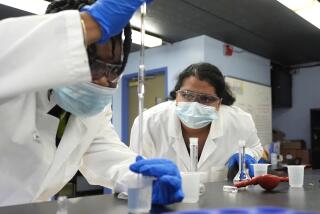NASA marks spot in lunar water hunt
NASA scientists announced Friday that they had picked a 60-mile-wide crater near the moon’s south pole as the place where they will send a rocket to punch a hole in the lunar surface next month in search of water.
Instruments aboard other satellites and on Earth have detected a significant amount of hydrogen, a telltale marker for water, on the northwest rim of the crater known as Cabeus A.
“We’re very confident we’re going to hit a good place,” Anthony Colaprete, lead scientist for the Lunar Crater Observation and Sensing Satellite, or LCROSS, mission, said at a briefing at Ames Research Center in Mountain View.
LCROSS consists of a small satellite and an accompanying rocket launched two months ago with a second spacecraft, the Lunar Reconnaissance Orbiter. Shortly after launch, the two spacecraft separated. While the lunar orbiter is using its instruments to map the moon remotely in search water traces, the smaller LCROSS satellite and its rocket are scheduled to plunge into the moon’s surface on Oct. 9.
If all goes according to plan, scientists say, the giant cloud of dust sent wafting over the lunar surface will contain traces of water in the form of ice.
The moon has long been thought to be a dead, dry world -- a place, in the words of astronaut Buzz Aldrin, of “magnificent desolation.” But some scientists have suggested that water ice millions of years old might be found in the shadowed craters of the north and south poles, where the sun never shines.
Finding water on the moon would not only be a major scientific discovery, it would also have a profound effect on plans to establish a semipermanent moon base. Water would not only be useful for drinking, it could also be used to produce oxygen for respiration and to serve as a source of rocket fuel for a trip to Mars.
Even though President Obama is reconsidering plans to return astronauts to the moon and, ultimately, Mars, NASA is proceeding under President George W. Bush’s ambitious Vision for Space Exploration.
The LCROSS mission has targeted the lunar south pole from the start. But NASA scientists said Cabeus A was chosen as the specific site after a vigorous debate that drew on data from a variety of resources, including Earth-based telescopes and Japanese and Indian satellites circling the moon in recent years.
Instruments have picked up evidence of large quantities of hydrogen in a number of places in the 2-mile-deep crater, scientists said. The current bull’s-eye, or “sweet spot,” Colaprete said in an interview, is a 2-mile-wide zone on the northwest rim of Cabeus A.
Hydrogen is no proof of water. It could be evidence of other compounds, such as methane. Even that would help scientists better understand the processes that helped build the inner solar system.
At about 4:30 a.m. Pacific time on Oct. 9, the LCROSS spacecraft is scheduled to send its accompanying Centaur rocket plunging into the crater. After the crash, the satellite is to fly through the dust cloud rising 2 miles above the moon’s surface. It will use its onboard instruments to sniff for water. After flying through the dust cloud, the satellite will itself plow into the lunar surface several miles away.
The event will be witnessed by observatories from Hawaii to New Mexico. The dust cloud should also be observable by amateur astronomers using telescopes with mirrors 10 inches or larger, Colaprete said. Managers at NASA’s Ames center plan to set up a huge outdoor screen to project video from the spacecraft as it plummets toward the moon. Colaprete said as many as 8,000 people are expected to attend.
If there is water beneath the crater, there could be as much as Lake Erie contains, or as little as 3% of the amount in the Great Salt Lake, depending on how far underground the water table is, said Dan Andrews, the LCROSS project manager.
--
More to Read
Start your day right
Sign up for Essential California for news, features and recommendations from the L.A. Times and beyond in your inbox six days a week.
You may occasionally receive promotional content from the Los Angeles Times.






